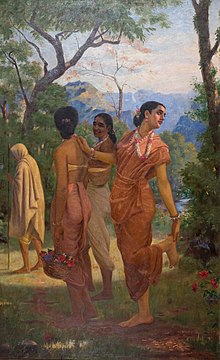മുണ്ടും നേരിയതും
മുണ്ടും നേരിയതും, കേരളത്തിലെ വനിതകളുടെ പാരമ്പര്യ വേഷമാണ്.[അവലംബം ആവശ്യമാണ്] സെറ്റ് മുണ്ട് എന്നും പറയും. ശരീരത്തിന്റെ അടിഭാഗം മാത്രം മറയ്ക്കുന്ന ശരിയുടെ (?) ഏറ്റവും പഴരൂപമാണിത്.[1][2]അതിലെ മുണ്ടിനാണ് കൂടുതൽ പാരമ്പര്യം അവകാശപ്പെടാനുള്ളത്.[അവലംബം ആവശ്യമാണ്] അതാണ് തുണി എന്നറിയപ്പെട്ടിരുന്ന സാരിയുടെ പുരാതന രൂപം,[അവലംബം ആവശ്യമാണ്] നേരിയത് മുണ്ടിന്റെ കൾ (?) ഭാഗമാണ്.[1][2]മുണ്ടുംനേരിയതും രണ്ട് രണ്ടു ഭാഗങ്ങളാണ്. നേരിയത് ബ്ലൗസിന്നുള്ളിൽ തിരുകിവച്ച് പാരമ്പര്യ രീതിലൊ എടതു ചുമലിൽ കൂടിയിട്ട് ആധുനിക രീതിയിലൊ ധരിക്കാം.[1]


ആരംഭം
തിരുത്തുകബുദ്ധ ജൈന സാഹിത്യങ്ങളിൽ പരാമർശിച്ചിട്ടുള്ള സാരിയുടെ മുൻ രൂപമായിരുന്ന "സത്തിക" യുടെ നിലനിൽക്കുന്ന രൂപമാണ്, മുണ്ടും നേരിയതും[അവലംബം ആവശ്യമാണ്][3] താഴെ ഭാഗത്ത് പ്രത്യേക രീതിയിൽ ധരിക്കുന്ന "അന്തരിയ"യുടെ കാലത്തെ അതിജീവിക്കുന്ന രൂപമാണ്.[അവലംബം ആവശ്യമാണ്][4]ജൈന-ബുദ്ധ സാഹിത്യങ്ങളിൽ പറയുന്ന വലതെ തോളിൽ നിന്ന് ഇടത്തെ തോളിലേക്ക് ധരിക്കുന്ന ഉത്തരീയത്തിന്റെ ആധുനികമായി ദത്തെടുത്ത രൂപമാണ് നേരിയത്.[അവലംബം ആവശ്യമാണ്][4][5]
അവലംബം
തിരുത്തുക- ↑ 1.0 1.1 1.2 Boulanger, C (1997) Saris: An Illustrated Guide to the Indian Art of Draping, Shakti Press International, New York. ISBN 0-9661496-1-0
- ↑ 2.0 2.1 Ghurye (1951) "Indian costume", Popular book depot (Bombay); (Includes rare photographs of 19th century Namboothiri and nair women in ancient saree with bare upper torso)
- ↑ Mahaparinibbanasutta (ancient Buddhist text)
- ↑ 4.0 4.1 Alkazi, Roshan (1983) "Ancient Indian costume", Art Heritage
- ↑ Mohapatra, R. P. (1992) "Fashion styles of ancient India", B. R. Publishing corporation, ISBN 81-7018-723-0